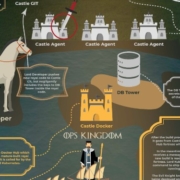What the Game of Thrones Night’s Watch Can Teach Us About DevOps Security
If you are reading this, you probably got sucked into watching Game of Thrones when it first aired on HBO in 2011. It is amazing how much has changed during the eight seasons of the series, but, as a developer and security guy, I find the Night’s Watch story the most interesting. The series debuts with the men in black – a.k.a the Night’s Watch – patrolling the wall. Soon, we learn that, contrary to popular belief, there really are supernatural threats lurking in the darkness that put all of Westeros at risk.
The Wall that the Night’s Watch guard is the only thing standing between the country of Westeros and the deadly White Walkers. However, rather than immediately getting all the resources they need to tackle this danger, the people of the Night’s Watch spend the next seven seasons convincing the rest of Westeros that these threats are real and that leaving the Wall woefully understaffed and poorly defended endangers everyone. Hmm…sounds familiar?
Source de l’article sur DZONE






